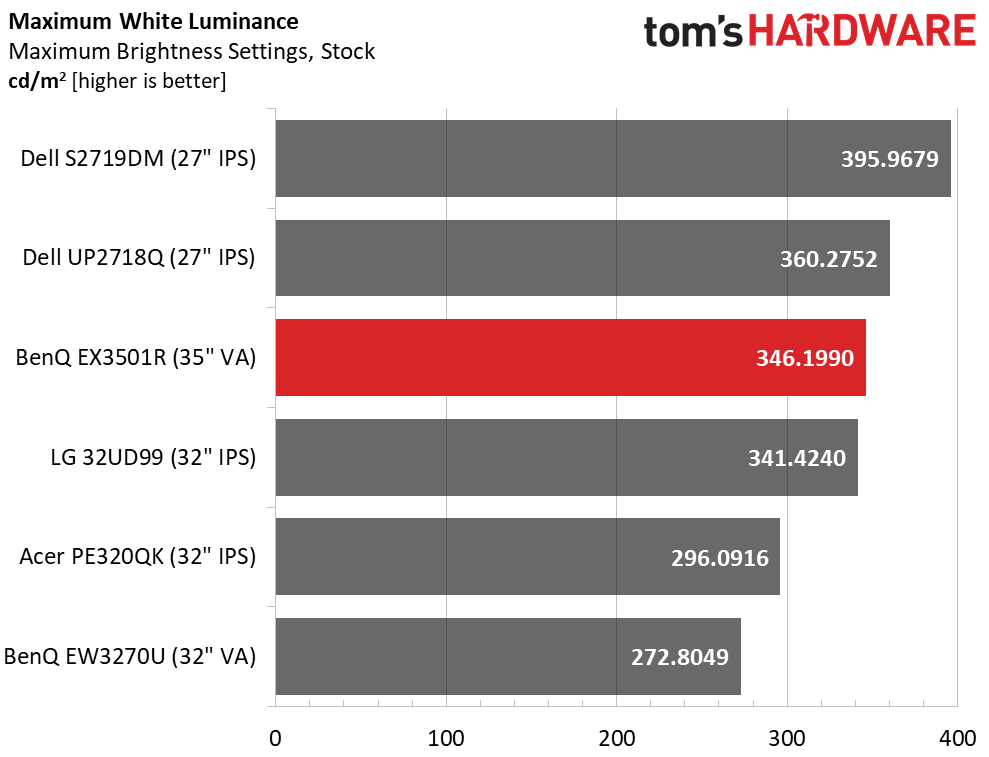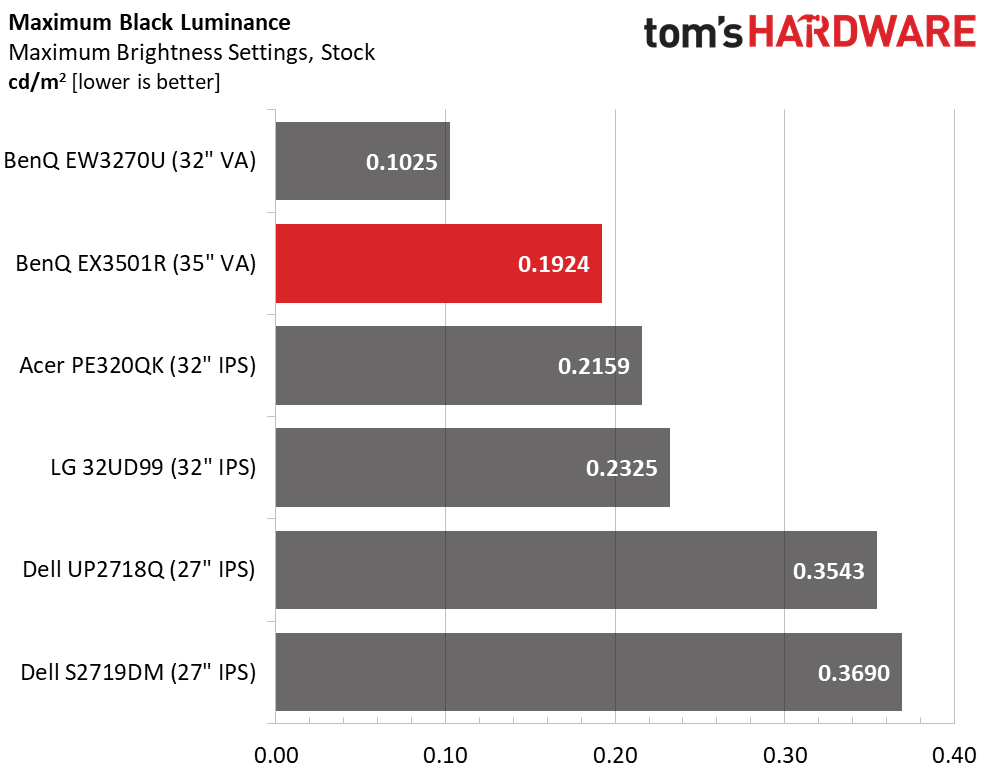BenQ EX3501R 35" VA Curved FreeSync HDR Gaming Monitor Review: Good Gaming, Great Looks
Why you can trust Tom's Hardware
Brightness and Contrast
To read about our monitor tests in-depth, check out Display Testing Explained: How We Test Monitors and TVs (see page two for Brightness and Contrast testing).
Uncalibrated – Maximum Backlight Level
We compared the EX3501R to other HDR monitors rather than bringing in gaming screens. This review is more about color, dynamic range and image quality, rather than speed. To that end, we have Dell’s S2719DM and UP2718Q, LG’s 32UD99, BenQ’s EW3270U, and Acer’s PE320QK. Like the EX3501R, the Acer monitor also offers FreeSync, but only at 60Hz maximum.



The EX3501R offers plenty of brightness in SDR mode. It doesn’t feature blur-reduction so there’s no need for any output overhead. At nearly 350 nits, it will work well in bright rooms with sunlit windows or perhaps in an outdoor setting under a tent. HDR is another matter; we’ll cover that in a moment.
The panel delivers better black levels than any IPS (in-plane switching, a screen technology for liquid-crystal displays) screen, but it’s a little short of the best VA examples we’ve measured. BenQ’s own EW3270U is another 46% darker, and that’s a visible difference. Resulting contrast for the EX3501R is 1799:1, which is good but not great.
Uncalibrated – Minimum Backlight Level



The minimum backlight level is just below 50 nits, our preferred lower limit. Gaming in the dark will work better if the brightness slider is set on 4 rather than bottomed out. Contrast remains consistent at 1790.3:1.
You can achieve deep blacks at 120 nits and below, but you’ll need to eliminate most, if not all, ambient light to see the effect. While the anti-glare layer is optically sound, it still reduces contrast unless you’re in total darkness.
After Calibration to 200 nits


During the EX3501R’s calibration, we lowered all three RGB sliders and the contrast control. We managed to increase dynamic range by selecting a darker gamma - 4 instead of 3. This is something many VA panels allow, and we recommend trying it regardless of brand or monitor type. The measured gamma rides just above 2.2 and delivers a punchy image with strong color saturation and excellent depth.
Get Tom's Hardware's best news and in-depth reviews, straight to your inbox.
HDR Brightness & Contrast



We couldn’t coax any more brightness from the EX3501R in HDR mode. Some monitors of this type can top, 500 nits but not this one. The black level is a little lower thanks to a subtle application of dynamic contrast. The ratio, 1995.3:1, is a tad higher than SDR, but not much. You get a little extra color with HDR material as well, but the overall effect is only slightly better.
Based on these results, this monitor is better-suited for gaming than watching movies. It has good motion processing, but its picture isn’t significantly better than any other non-HDR VA display.
ANSI Contrast Ratio
This monitor's intra-image contrast is better than most IPS screens, boasting a 1532.8:1 ANSI result. There are some VA monitors with higher results, but dynamic range should be a secondary consideration if selecting this product. Instead, buy the EX3501R for its speed and FreeSync.
MORE: Best Gaming Monitors
MORE: How We Test Monitors
MORE: All Monitor Content
Current page: Brightness and Contrast
Prev Page OSD Setup and Calibration Next Page Grayscale, Gamma and Color
Christian Eberle is a Contributing Editor for Tom's Hardware US. He's a veteran reviewer of A/V equipment, specializing in monitors. Christian began his obsession with tech when he built his first PC in 1991, a 286 running DOS 3.0 at a blazing 12MHz. In 2006, he undertook training from the Imaging Science Foundation in video calibration and testing and thus started a passion for precise imaging that persists to this day. He is also a professional musician with a degree from the New England Conservatory as a classical bassoonist which he used to good effect as a performer with the West Point Army Band from 1987 to 2013. He enjoys watching movies and listening to high-end audio in his custom-built home theater and can be seen riding trails near his home on a race-ready ICE VTX recumbent trike. Christian enjoys the endless summer in Florida where he lives with his wife and Chihuahua and plays with orchestras around the state.
-
Diji1 >Right now, there are no games that can take advantage of HDRReply
Uh ... Assassin's Creed: Origins, Final Fantasy VI? -
DerekA_C mass effect andromeda I'm more concerned with that 4ms at 100hz YUCK already bought ASUS version and it was TRASH returned it motion blur and input lag VA is not where it needs to be yet ISP is still better.Reply -
jcroe72 why are screens being made with internal bezel a portion of the edges being useless its very ugly and misleadingReply -
Dantte Reply21097935 said:mass effect andromeda I'm more concerned with that 4ms at 100hz YUCK already bought ASUS version and it was TRASH returned it motion blur and input lag VA is not where it needs to be yet ISP is still better.
I think you're confusing response time with input lag:
Response Time is a measure of how fast a pixel can turn on/off (yes I'm simplifying this...) and is what affects "motion blur". VAs are generally faster and better then IPS here and there are ways to fix a monitor with a slow response such as using ULMB.
Input Lag is the time it takes for a signal sent out by the source to be displayed on the screen, this has no effect on motion blur and IPS are generally faster than VA here. Example, click you mouse button and (40ms) later that action takes place on the screen, this is input lag.
If you're truely concerned about either of the above items, get a TN panel as it smokes both IPS and VA in both fields, but you will lose a lot of color, contrast, and viewing angle with a TN. I use to do competitive game and my main gaming monitor is still a TN; anytime I'm on a VA or IPS something just feels off and i suspect its the display speed. I didnt give up my CRT (NEC FP2141SB) as my main gaming monitor until 2012 if this says anything about it... -
Colin_10 Been waiting for a monitor like this, after experiencing 144hz, going back to a 60hz monitor just for the larger size and curvature wasn't acceptable. A Curved/Freesync/VA/100Hz is in the sweet spot for me.Reply



